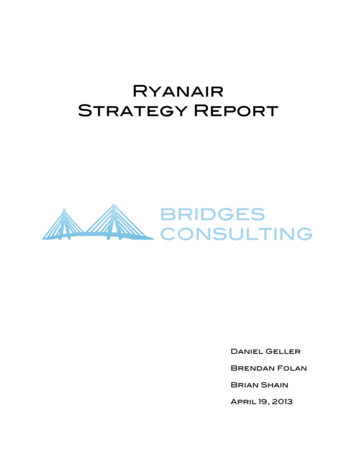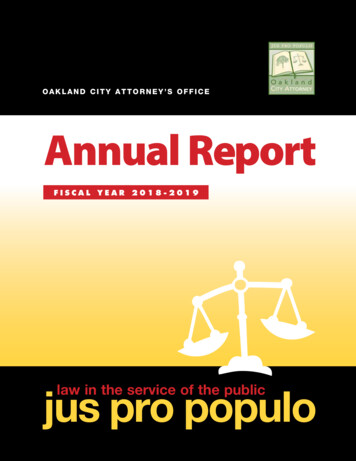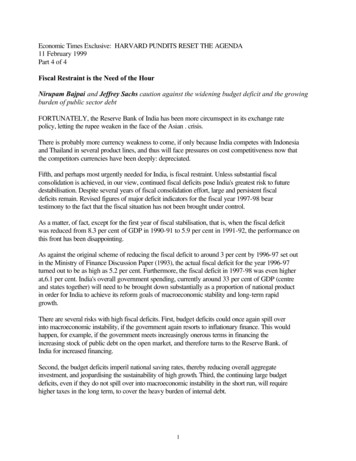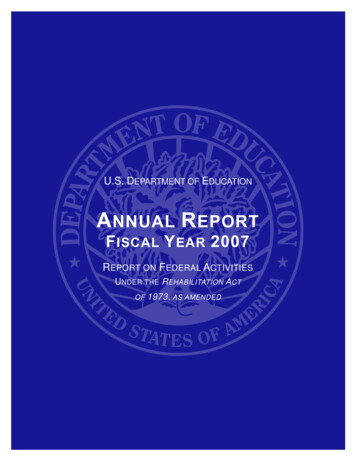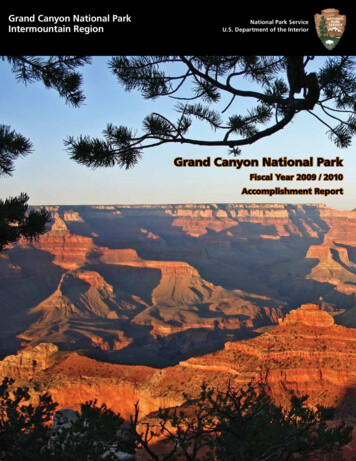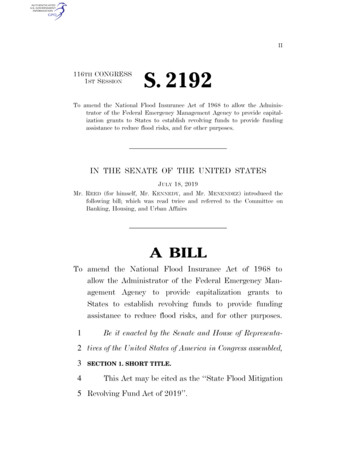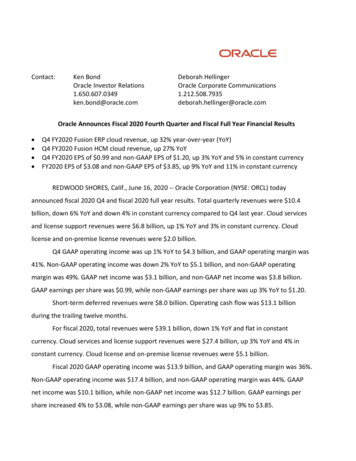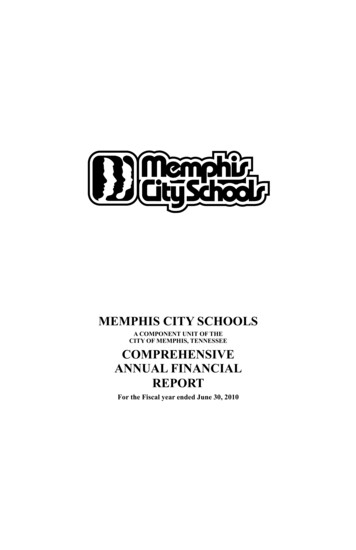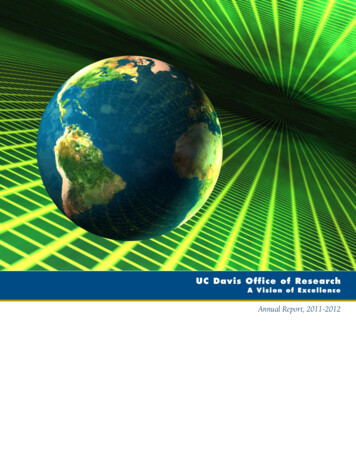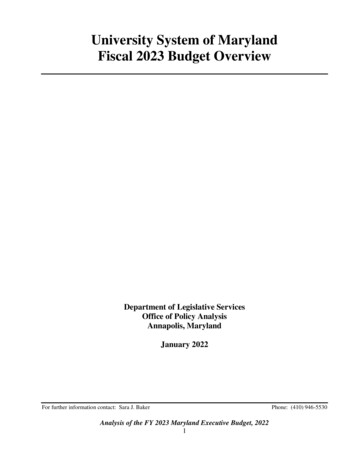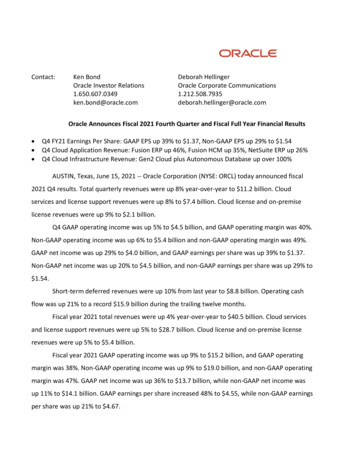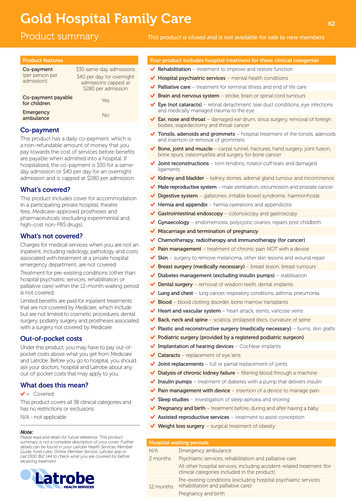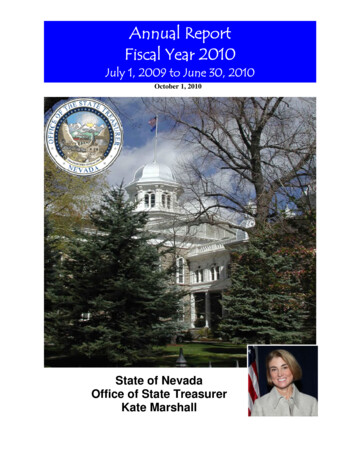
Transcription
Annual ReportFiscal Year 2010T H E S T A T E T R E A S U R E RJulyO1,F 2009to June 30, 2010O F F I C EOctober 1, 2010State of NevadaOffice of State TreasurerKate Marshall
MISSION STATEMENTThe Nevada State Treasurer’s Office adheres to sound fiscal policy principles—including the prudent and conservative financial management of all state monies—by ensuring the state’s money is invested with an emphasis on preservation of assets,then on return, and that the state’s debt obligations are paid timely and accurately;that money entrusted by participants in the Nevada Prepaid Tuition and Nevada 529College Savings Plans programs, as well as tobacco settlement monies received by thestate and used to operate the Gov. Guinn Millennium Scholarship program, the Fundfor a Healthy Nevada, and the Public Health Fund is managed, monitored, andinvested with the intent of maximizing earnings while maintaining the highestdegree of safety; and that unclaimed property held by the state is returned asjudiciously as possible to its rightful owners.NEVADA STATE TREASURER22010 ANNUAL REPORT
Dear Gov. Gibbons and Members of the Legislature:As required by NRS 226.120, it is my pleasure to present you with the StateTreasurer’s Office Annual Report for Fiscal Year 2010 (FY10), an account of theoperations of the Treasurer’s Office over the past fiscal year.For FY10, investment interest earnings on the state’s General Portfolio came in at 7.5 million. As of June 30, 2010, total assets under management were almost 2.78 billion. Our debt service payment reserves increased to 10 months, wellabove the standard “best practice” of six months of reserve.For FY10, the State Treasurer’s Office had an approved budget over all functional areas of 6,280,777;however, only 5,459,841 was spent, saving more than 800,000 in taxpayer dollars. Further, only 21% of thetotal expenditures were paid for with General Fund appropriation, with the balance being funded by assessmentsand trust fund transfers, a further savings of taxpayer money.In spite of one of the worst financial crises the nation and state have faced, the Treasurer’s Office was able towork with the Governor’s Office and legislators to maintain the state’s good credit rating through prudent fiscaladministration and debt management.The Unclaimed Property Division had another banner year in FY10, with 88.8 million in collections and nearly 21 million returned to owners. In fact: collections from holders in FY10 were almost 200% above collectionsin 2005; individual claims paid have increased by 94.7% since 2005, while the dollar amount returned hasincreased by 160%. Further, as a direct result of expanded outreach and the adoption of “Best Practices,” theState Treasurer’s Office was able to transfer more than 66 million to the state General Fund to be used tosupport critical programs in the state at a time when budget restraints are extraordinary tight, the highest amountin the state’s history.Other noteworthy accomplishments achieved during FY10: the Nevada Prepaid Tuition program achieving anear 100% funded status and doubling the number of new contracts purchased compared to FY07; the state’sCollege Savings Plans program continuing to be ranked in the top ten nationally; the renegotiation of the state’scontract with the College Savings Plans program manager resulting in several fee reductions for accountholders, as well as greater benefits to the state; the adoption of a Fast Track Claims process and a VoluntaryDisclosure Agreement program by the Unclaimed Property Division; and the successful issue of Build AmericaBonds in relation to the American Recovery and Reinvestment Act, resulting in a savings to taxpayers of 4.6million.In cooperation with the Governor and Legislature, I look forward to continuing our efforts to increaseefficiencies and cost-saving ideas aimed at providing the best services at the least expensive cost to the people ofNevada.Respectfully submitted,Kate MarshallState TreasurerNEVADA STATE TREASURER32010 ANNUAL REPORT
TABLE OF CONTENTSOverview of the State Treasurer’s Office . 5Organization Chart 7College Savings Plans/Nevada Prepaid Tuition. . .8Gov. Guinn Millennium Scholarship Program .15Unclaimed Property . . .18Cash Management .21Investments .23Debt Management .27Health Trust Funds. . .31Information Technology Group .33Staff Profiles 34Kate Marshall’s Biography .38Financial Section .41Picture CreditsCoverFormer Nevada State Photographer Rich JohnstonInsideNevada State Photographer Julie DuewelNEVADA STATE TREASURER42010 ANNUAL REPORT
OOVVEERRVVIIEEWWThe Office of State Treasurer was created in 1864, under Article 5, Section 19, ofthe Constitution of the State of Nevada. The State Treasurer is elected to a fouryear term and the general responsibilities include the receipt and safeguarding ofall money of the State which is not expressly required by law to be received andkept by some other person; the disbursement of state money through electronicmeans and checks drawn upon the Treasury by the State Controller; the investmentof all available state funds which include, but are not limited to, the GeneralInvestment Portfolio, Local Government Investment Pools, Prepaid TuitionProgram, 529 College Savings Plan, and the Permanent School Fund; the issuanceof any debt obligation authorized on behalf and in the name of the state (with fewexceptions); and managing the state’s Unclaimed Property and Pooled Collateralprograms.The office is divided into six functional areas: Administration, Cash Management, Debt Management,Investments, Education Programs, and Unclaimed Property.The mission of the State Treasurer's Office is to:Provide ethical financial leadership to the state;Provide prudent and conservative financial management of all state monies;Provide professional and judicious fiscal management of all state monies;Maximize earnings while maintaining the highest degree of safety;Assist families in providing for their children's higher education;Maintain the highest degree of public confidence and accountability;Maintain an organization which exudes confidence and professionalism; andPromote efficiencies through technological advances and best practices.Statutory responsibilities of the State Treasurer:Member of the State Board of Finance;Ex-Officio State Disbursing Office for the federal government;Administrator of the Municipal Bond Bank;Chairman of the Board of Trustees of the College Savings Plans of Nevada;Administrator of the 529 College Savings Plan and Trust Fund;NEVADA STATE TREASURER52010 ANNUAL REPORT
Administrator of the Nevada Prepaid Tuition Program and Trust Fund;Administrator of the Fund for a Healthy Nevada and the Trust Fund for Public Health;Member of the Executive Branch Audit Committee;President of the Nevada Real Property Corporation; andAdministrator of the Nevada Unclaimed Property Division.For FY10, the State Treasurer’s Office had an approved budget, over all functional areas, of 6,280,777 but expended only 5,459,841. Only 21% of the total expenditures were paid for withGeneral Fund appropriation, with the balance being funded by assessments and trust fund transfers.State Treasurer Kate Marshall with executive staff members:Mark Mathers, Steve George, Karen Duddlesten, and Mark Winebarger.NEVADA STATE TREASURER62010 ANNUAL REPORT
NEVADA STATE TREASURER72010 ANNUAL REPORT
NNEEVVAADDAACCOOLLLLEEGGEE SSAAVVIINNGGSS PPLLAANNSS;;NAIIDD TTUUIITTIIOONNNEEVVAADDAA PPRREEPPAThe State Treasurer administers two types of qualified 529 plans: the Nevada PrepaidTuition program and the Nevada 529 College Savings Plans, as authorized by 26U.S.C. § 529. The programs are designed to assist parents and students in takingadvantage of the Internal Revenue Service 529 College Savings Plans, which offersavings and tax advantages to account holders.NEVADA 529 COLLEGE SAVINGS PLANSThe State Treasurer’s Office partners with Upromise Investments to help Nevada residents andfamilies across the country save for college. The Nevada 529 College Savings Plans combines taxbenefits and flexible features, making it a smart and easy way to save for college. Under the InternalRevenue Code regarding 529 College Savings Programs, earnings in the account growtax-deferred and, if used for qualified educational expenses, are withdrawn tax-free. This allowssavings to grow faster, providing more money toward college-related expenses.The Nevada 529 College Savings Plans consist of three direct sold programs: Upromise College Fund529 Plan, Vanguard 529 College Savings Plan, and USAA College Savings Plan; and one advisor-soldplan (Columbia 529 Plan). As of June 30, 2010, there were 444,904 accounts actively managed acrossall four of these plans, with 5,888,647,524 in assets under management.Three of Nevada’s premier college savings plans programs—USAA College Savings Plan, TheVanguard 529 Savings Plan and the Upromise College Fund—were ranked in the top ten nationally for3-year performance by Savingforcollege.com, an independently sponsored website dedicated toassisting parents and students with planning for college.Three-year performance ranking (Updated May 11, 2010)RankStatePlanPercentile1NevadaUSAA College Savings Plan14.772KansasSchwab 529 College Savings Plan21.993NevadaThe Vanguard 529 Savings Plan32.674WisconsinEdVest (Direct-sold)34.305LouisianaSTART Saving Program35.596UtahUtah Educational Savings Plan (UESP) Trust36.717South CarolinaFuture Scholar 529 College Savings Plan (Direct-sold)36.858NevadaThe Upromise College Fund37.449OhioOhio College Advantage 529 Savings Plan37.7810PennsylvaniaPennsylvania 529 Investment Plan38.20NEVADA STATE TREASURER82010 ANNUAL REPORT
Marketing has played a keyroleinincreasedparticipation in Nevada’sCollege Savings Plans andNevada Prepaid Tuitionprograms.The college savings programs offer a variety of market-based savings options. Each portfolio has adifferent allocation of stock, bond, and money market funds. The investor selects a portfoliodepending on his/her own risk tolerance and the amount of time until the child enters college. Anyperson may open a 529 college savings account by contributing as little as 50 per month or by makinga minimum one-time investment of 250. The maximum that can be saved in a 529 plan is 370,000.These accounts may be used for any qualified education expenses at any eligible post-secondary schoolin the world, including two and four year colleges, technical and trade schools, and graduate school.Ugift ProgramIn collaboration with Upromise Investments, Nevada launched the Ugift program in November 2007,which invites friends and families to give the gift of college savings, in lieu of traditional gifts. Threeof Nevada’s plans—Upromise College Fund, USAA College Savings, and Vanguard 529 SavingsPlan—offer the Ugift option. By the end of FY 2010, Ugift accounts had accumulated nearly 5million in gift contributions since inception more than doubling contributions through Ugift in oneyear.Silver State Matching GrantThe Silver State Matching Grant allows qualifying Nevada families who are Upromise College Fund529 Plan account owners to be considered for a matching grant of up to 300 of extra college savingsper calendar year, with a lifetime maximum grant of 1,500. The program, which opened March 1,2010, received thirty-six qualified applications in its first year.NEVADA STATE TREASURER92010 ANNUAL REPORT
Increased Services to NevadansNegotiated contract provisions in FY10 between Treasurer Marshall and the program manager of theCollege Savings Plans of Nevada produced several new benefits: 400,000 commitment in marketing for the Upromise College Fund to increase new accountsand participation in the Plan.Dedicated in-state field representative to work with local businesses and organization toincrease awareness of college savings, the Upromise College Fund and to provide assistance toNevada families in establishing accounts for the children in our state.New revenue to the state in the form of additional fees paid to Nevada targeted to beginimplementation when the Upromise College Fund reached 750 million in assets undermanagement (This goal was met well in advance of expectations, resulting in the statereceiving its first payment in May 2010).Fee reductions for account holders in the Upromise College Fund, reducing the amount familiesare charged for the management of accounts.Nevada College Savings Plans and Upromise College Fundmarketing staff at a local Las Vegas PTA event.Increase Nevada ParticipationWith the intent of increasing Silver State participation in the Nevada College Savings Plans and theNevada Prepaid Tuition programs, the State Treasurer’s Office continued the grassroots media andoutreach campaign aimed at increasing the awareness of Nevada residents about the value of savingfor college and the availability of our programs. Several avenues were successfully used in thecampaign: In collaboration with the Nevada Bankers Association, sponsoring the Nevada 529 CollegeSavings Day Contest, which in FY10 awarded six 529 college savings accounts to elementaryschool students selected from throughout the state. More than 800 youngsters entered thecontest.NEVADA STATE TREASURER102010 ANNUAL REPORT
Participated in over 120 local community events, such as the Parent Teacher AssociationConvention, local parent meetings, college and career day activities, and other eventsthroughout the state.In-state marketing efforts showed that Nevada was one of only two states in the country toproduce more new accounts for the Upromise College Fund over 2009 totals.2010 Nevada 529 College Savings Day contests winners Makayla Beech, Molly Rice,Joseph Keith, Elena Brown, Alexander Ramirez, and Takota Nelson.NEVADA STATE TREASURER112010 ANNUAL REPORT
Account Information:Upromise Vanguard Columbia USAACollege529 Plan529 Plan 529 eCollege FundVanguard529 PlanColumbia529 PlanUSAA529 PlanTotal2005 261,630,755 1,137,692,239 81,402,014 153,351,294 1,634,076,3022006 383,842,469 1,871,984,679 98,035,268 246,846,481 2,600,708,8972007 564,881,385 2,972,622,759 125,472,185 400,566,218 4,063,542,5472008 630,076,335 3,493,167,241 122,811,600 490,988,322 4,737,043,4982009 608,228,558 3,343,224,153 97,637,879 519,141,031 4,568,231,6212010 738,274,807 4,303,662,470 108,432,416 738,227,830 4,573,993,189Number of Nevada Accounts:YearUpromiseCollege FundVanguard529 PlanColumbia529 PlanUSAA529 1,1256,979NEVADA STATE TREASURER122010 ANNUAL REPORT
Financial Management of College SavingsThe Board of Trustees of the College Savings Plans of Nevada, which is chaired by TreasurerMarshall, provides financial oversight for the investment managers, program managers and accountholders in the College Savings Program. In order to perform a higher level of investment and financialoversight and stability within the College Savings Programs, several new policies and long term planswere developed. A Comprehensive Investment Plan was developed and approved for the CollegeSavings Plans.Investment Policies for the Nevada Prepaid Tuition Program were updated, a majorrevision of the Master Agreement was completed, and the long-term financial health ofthe Program was reviewed.A 10 Year Plan for the College Savings Endowment Account was established, whichincluded funding for several items: detailed financial monitoring, an updated customerservice website access system, and 5.5 million stabilization funding to the NevadaPrepaid Tuition Program.NEVADA PREPAID TUITION PROGRAMThe Nevada Prepaid Tuition Program, which began in 1998, continues to offer a smart savings optionto Nevada residents or graduates of the Nevada System of Higher Education looking to begin a collegesavings program for their newborn to ninth grade child. The program provides parents, grandparents,family members, and friends a variety of options to make participation in the program easy andconvenient. Nevada Prepaid Tuition contracts can be satisfied with a lump sum payment, paymentsspread out evenly over sixty months, or from time of enrollment until the child is ready to start college.At the conclusion of FY10, more than 13,525 children had enrolled in the program, and the NevadaHigher Education Tuition Trust Fund had assets of 107.5 million.The Nevada Prepaid Tuition program is transferrable to private or public out-of-state colleges anduniversities, and can be transferred to another family member, including a first cousin. As of June 30,2010, there were more than 1,750 students using their benefits and the program had paid out over 4.65 million in tuition benefits on behalf of these students, an increase of slightly over 570,000 fromFY09.Due primarily to the grassroots marketing plan the State Treasurer’s Office developed and directed inthe spring of 2009, new enrollment in Nevada Prepaid Tuition nearly doubled from FY08, withsignificant improvement in participation by rural community families, a historically underservedpopulation. Enrollment during the 2010 open enrollment period increased significantly once program’s13 month total to more than 900 new contracts.NEVADA STATE TREASURER132010 ANNUAL REPORT
Nevada Prepaid TuitionEnrollment Comparison by 92656633.17%Washoe1281714333.59%Other Nevada Counties717545.63%Out of State Counties135-8-61.54%411516105UP 25.5%CountyTotalNEVADA STATE TREASURER142010 ANNUAL REPORT
GGOOVV. GGUUIINNNNMMIILLLLEENNNNIIUUMM SSCCHHOOLLAARRSSHHIIPPIn 1999, the Legislature unanimously approved the dedication of 40 percent ofNevada’s Tobacco Master Settlement Agreement payments to fund the MillenniumScholarship Program, which by legislative decree during the 2007 session wasrenamed after former Gov. Kenny Guinn.The program provides scholarship funding toward attendance at any college or university located in thestate to Nevada high school students who, as of June 2009: Graduated with a minimum GPA of 3.25Has been a resident and attended a high school in Nevada for at least two yearsGraduated with a diploma from a public or private Nevada high schoolPassed the Nevada High School Proficiency ExaminationCompleted a core curriculum consisting of 4 units of math (including Algebra II), 4 units ofEnglish, and 3 units each of natural and social sciences.There is no application process for the student to complete. Nevada high schools electronically submitthe names of eligible students to the Millennium Scholarship Program in the Treasurer’s Office.Including the graduating class of 2010, more than 93,000 high school seniors have been eligible for theMillennium Scholarship, with an average utilization rate of over 71 percent since the program wasestablished. By the end of the spring 2010 school term, more than 228 million had been distributed to59,785 Millennium Scholars, who collectively earned more than 20,910 associate, bachelor, and othercertificates and degrees.Millennium Scholarship Executive Director Reba CoombsNow in its tenth year, the Gov. Guinn Millennium Scholarship Program has continued to recognize,make contact with, and support students in their pursuit of higher education. The State Treasurer’sOffice partners and collaborates with the Nevada System of Higher Education and the NevadaDepartment of Education to enhance and support Millennium Scholars.NEVADA STATE TREASURER152010 ANNUAL REPORT
During the 2009 legislative session, two bills provided enhancements to the program: Assembly Bill96 established a co-enrollment policy whereby a student can be enrolled in two eligible institutions andcontinue to receive Millennium funding from both institutions; Senate Bill 209 allows an extension ofthe 6-year expiration deadline if a student is participating in a charitable, religious, or public serviceassignment or mission.Due to enormous budget constraints felt by the Legislature as a result of one of the worst economicperiods in our nation’s history, decisions were made by the Legislature to remove 32.8 million inmillennium scholarship funding. Although funding for the Gov. Guinn Millennium Scholarshipprogram does not come from General Fund dollars, the Legislature felt it necessary to remove theprogram’s normal funding mechanisms—tobacco master settlement agreement monies and unclaimedproperty transfers—to pay for other programs administered by the state.Coupled with anunanticipated, lower-than-projected April 2010 payment to the state as part of the tobacco mastersettlement agreement, the Gov. Guinn Millennium Scholarship program was projected to incur ashortage during FY11. Working with legislators to find a solution became a main focus of the office.Fortunately, a funding mechanism was identified to make this valuable program whole through thecoming school year. However, the future of the Gov. Guinn Millennium Scholarship rests in the handsof the 2011 Legislature.There are seven Nevada System of Higher Education (NSHE) eligible institutions where students mayutilize their scholarship award, as well as Sierra Nevada College in Incline Village, and the Universityof Southern Nevada in Henderson.An administrator of the program, the State Treasurer’s Office continues to: Operate the program’s database (MiSL: Millennium Scholarship Ledger), which collects, stores,and maintains data on Millennium Scholars. Collect data from high schools on eligible high school seniors in a fully automated and securemethod so they can be provided award packets with the scholarship information. Conduct outreach efforts throughout the state at college fairs, schools, private companies, PTAgroups, and other venues to hear about the Millennium Scholarship Program. Cooperate with representatives of each NSHE institution, NSHE System Administration, SystemComputing Services, Millennium Scholarship Advisory Committee, Nevada Association ofSchool Superintendents, Leadership Forum of High School Counselors, and the NevadaDepartment of Education to enhance outreach efforts. Collect eligibility data from 17 county school districts, 39 private high schools, adult education,GED, and home school applicants. Disseminate information to Nevada high school students, high school counselors, NSHEinstitutions, and the general public. Work with the Millennium Scholarship Advisory Committee and NSHE System ComputingServices on a system-wide review process to review balance irregularities.NEVADA STATE TREASURER162010 ANNUAL REPORT
The following table identifies the number of Millennium Scholars enrolled in a community college,state college, or university during FY 2010.Enrollment by Institution by SemesterSpringSummer20092009College of Southern Nevada2,565807Great Basin College2255Nevada State College23171Sierra Nevada College214Truckee Meadows Community College1,139370University of Nevada, Las Vegas4,8732,374University of Nevada, Reno4,4301,534Western Nevada College41554University of Southern Nevada00Totals13,8995,219Institution venues, expenses, and fund balance for the Millennium Scholarship Fund for FY 2010:July 1, 2009 fund balanceTobacco settlement revenuesInterest incomeLess tuition paymentsLess administrative expensesTransfer from College Savings Endowment AccountJune 30, 2010 fund balanceNEVADA STATE TREASURER17 18,753,461 16,586,869 71,062 25,506,259 365,694 2,654,442 12,193,8812010 ANNUAL REPORT
UUNNCCLLAAIIMMEEDD PPRROOPPEERRTTYY DDIIVVIISSIIOONNThe State of Nevada’s Unclaimed Property Division has the responsibility ofcollecting, safeguarding, and distributing unclaimed property for current and pastresidents and businesses. Companies and governmental agencies are required byNRS 120A to submit annual holder’s reports and to turn over to the stateunclaimed intangible assets and contents of safe deposit boxes. Assets includesecurities, bank deposits, payroll checks, utility deposits, insurance proceeds, andother items specified in Nevada’s statutes. Property is considered abandoned whenit remains unclaimed for the number of years prescribed by statute. The person,business, or legal entity entitled to receive the property never loses the right to makea claim for the asset (or value of items sold). Owners could include the estate orthe heir to the original owner.During FY10, the Unclaimed Property Division continued its mission of improving collections ofunclaimed property from holders while, at the same time, delivering greater returns to rightful owners.Collections topped the 88.8 million mark in unclaimed property from holders, with returns to rightfulowners surpassing 20.6 million. In fact, in comparison to FY05: collections have increased byapproximately 200%, individual claims paid have increased by 94.7%, and the dollar amount paid torightful owners has increased by 160%. Further, for FY10, the State Treasurer’s Office transferredmore than 66 million to the state General Fund to be used to support critical programs in the state at atime when budget restraints are extraordinary tight, the highest amount in the state’s history.As part of the Division’s continuing efforts to improve the claims process, a new Fast Track processwas initiated in FY10 that allows a claim to be paid through an automated process. Of the 14,449claims paid by the Division in FY10, 29% were paid via Fast Track. Claims under 1,500 are eligiblefor the Fast Track process. As a result of this innovative process being adopted, claimants receive theirmoney in a fraction of the time as compared to a manual claim. In addition, the new user-friendlyprocess has resulted in an 18% increase over FY 09 in the number of claims paid.Total Unclaimed Property receiptsPayments to claimantsAdministrative costsTransfer to Millennium Scholarship FundTransfer to Educational Trust Fund FY1088,827,48920,683,6771,933,13708,910 FY0977,265,40125,390,2901,743,148040,570At the conclusion of FY10, the state was holding approximately 409 million in unclaimed property.The State Treasurer’s Office, Nevada Unclaimed Property Division, continues to utilize many methodsadopted since Treasurer Marshall took office to reunite rightful owners with their unclaimed property: A user-friendly website (nevadatreasurer.gov) that provides individuals the ability to easilysearch the state’s database of abandoned property, as well as to initiate claims.NEVADA STATE TREASURER182010 ANNUAL REPORT
Member of the National Database website sponsored by the National Association of UnclaimedProperty Administration (NAUPA), which provides a national search engine for unclaimedproperty.A revised holder outreach program that has dramatically increased the number of properties beingreported to the state.Public notices being published in 17 newspapers throughout the state identifying unclaimedproperty held by the state, along with the name of the rightful owner.As part of the Division’s continuing efforts to assist holders, a Voluntary Disclosure Agreementprogram was established in FY10 to encourage non-compliant businesses to conform to Nevada’sunclaimed property laws without penalties and interest being added. The VDA program provides anavenue for businesses which may not have realized they were out of compliance with an opportunity towork with the Unclaimed Property Division to submit past due reports. Further, new publications werecreated with the intent of providing holders with easy to understand and follow instructions on how tobest comply with Nevada’s unclaimed property laws.NEVADA STATE TREASURER192010 ANNUAL REPORT
The Unclaimed Property Division conducts an auction in Las Vegas once a year of property heldby the state that has passed the statutorily-mandated abandonment period.Abandoned property can be any financial asset owed to a business or an individual. Property isconsidered abandoned when there has been no activity and/or contact with the owner for a specificperiod of time. The property type will determine the abandonment period; however, it is generallythree years. When a holder's attempts to locate the rightful owner have been unsuccessful, the assetsmust be escheated (turned over) to the state of the last known address. The State Treasurer's Office isresponsible for protecting the assets and advertising the rightful owners' names in attempting to returnthe assets to the rightful owners. Examples of abandoned/unclaimed property include: bank accounts;un-cashed payroll checks, insurance checks, traveler's checks; utility deposits; gift certificates; stocks,bonds, mutual funds, dividends; insurance policy benefits, or claim payments; safe deposit boxcontents; oil and gas royalties; and court deposits. Abandoned/unclaimed property does not includereal estate or land, automobiles, boats, taxes, or most other tangible properties.Nevada Unclaimed Property Division staff located in the Las Vegas Office.NEVADA STATE TREASURER202010 ANNUAL REPORT
CCAASSHHMMAANNAAGGEEMMEENNTT DDIIVVIISSIIOONNThe primary duty of the Cash Management Division is to manage the state’sbanking relationships, assist state agencies with banking needs, and operate thestate’s Pooled Collateral Program. The Division is also responsible for theTreasurer’s Office administrative and accounting functions.The Cash Management Division oversees the sta
1 Nevada USAA College Savings Plan 14.77 2 Kansas Schwab 529 College Savings Plan 21.99 3 Nevada The Vanguard 529 Savings Plan 32.67 4 Wisconsin EdVest (Direct-sold) 34.30 5 Louisiana START Saving Program 35.59 6 Utah Utah Educational Savings Plan (UESP) Trust 36.71 7 South Carolina Future Scholar 529 College Savings Plan (Direct-sold) 36.85 8 .
